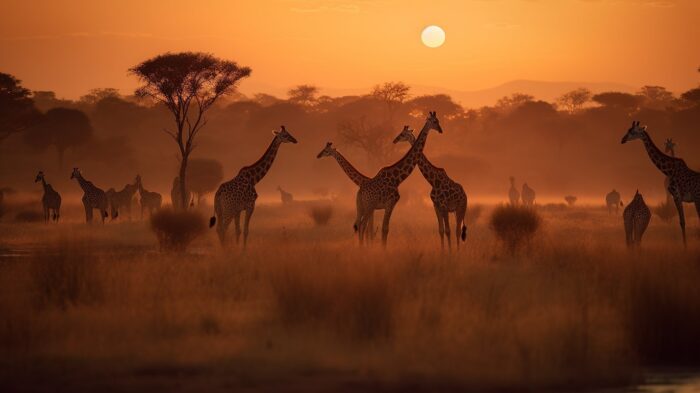The African savannah, a sprawling landscape characterized by its grasslands, scattered trees, and diverse wildlife, has come to face numerous threats from human activities and climate change. Amidst these challenges, community-led wildlife sanctuaries have emerged as a beacon of hope for the conservation of endangered species. Steve Wentzel explores how these sanctuaries, managed by local communities, provide safe havens for wildlife, foster biodiversity, and promote sustainable living practices.
The Need for Community-Led Sanctuaries
The African savannah is home to iconic species such as elephants, lions, rhinos, and cheetahs. However, these animals are increasingly at risk due to habitat loss, poaching, and human-wildlife conflict. Traditional conservation efforts, often led by external organizations, have had mixed results. In contrast, community-led wildlife sanctuaries leverage local knowledge, foster community engagement, and ensure that conservation benefits are shared among the local population.
Community-managed sanctuaries address the root causes of wildlife decline by integrating conservation with local livelihoods. These initiatives empower communities to take charge of their natural resources, creating a sense of ownership and responsibility. Moreover, they offer economic incentives through eco-tourism and sustainable resource management, which can reduce dependence on activities that harm wildlife.
Success Stories Across the Savannah
Several community-led wildlife sanctuaries across the African savannah serve as exemplary models of conservation success. One such sanctuary is the Ol Pejeta Conservancy in Kenya. Managed by local communities and the Northern Rangelands Trust, Ol Pejeta is a sanctuary for critically endangered species such as the northern white rhino and the Grevy’s zebra. The conservancy employs over 800 local people, providing a significant economic boost to the surrounding areas.
The Ol Pejeta model emphasizes the importance of combining wildlife conservation with community development. Revenue from tourism and conservation activities helps to fund healthcare, education, and infrastructure projects for local communities. This holistic approach ensures that conservation efforts remain sustainable and beneficial to all stakeholders.
In Namibia, the Nyae Nyae Conservancy stands out as another successful example. Established by the Ju/’hoansi San people, the conservancy covers an area of over 9,000 square kilometers and is home to elephants, lions, and various antelope species. The Ju/’hoansi people, traditionally hunter-gatherers, have embraced wildlife conservation as a means to preserve their cultural heritage and secure their future.
The Nyae Nyae Conservancy operates on a community-based natural resource management (CBNRM) model, which integrates traditional knowledge with modern conservation practices. This model has proven effective in reducing poaching and human-wildlife conflict while enhancing the community’s own capacity to manage their resources sustainably.
Challenges and Solutions
Despite their successes, community-led wildlife sanctuaries still face several challenges. One major issue is the lack of consistent funding. Conservation projects often rely on donor support, which can be unpredictable and insufficient. To address this, many sanctuaries are diversifying their income streams through eco-tourism, sustainable agriculture, and carbon credits.
Another challenge is the human-wildlife conflict, which can arise when animals encroach on human settlements or agricultural lands. Community sanctuaries mitigate this by implementing conflict resolution strategies, such as building wildlife corridors, installing predator-proof bomas (livestock enclosures), and using early warning systems to alert communities of wildlife movements.
Capacity building is also crucial for the long-term success of community-managed sanctuaries. Training programs in wildlife management, eco-tourism, and sustainable agriculture equip community members with the skills they will need to manage their resources effectively. Additionally, fostering partnerships with government agencies, NGOs, and private sector stakeholders can provide technical support and enhance the sanctuaries’ conservation impact.
The Role of Technology
Technology plays an increasingly important role in the management of community-led wildlife sanctuaries. Drones, GPS tracking, and camera traps are used for wildlife monitoring and anti-poaching efforts. These tools provide real-time data on animal movements and population dynamics, enabling more effective management decisions.
Furthermore, digital platforms facilitate community engagement and education. Social media, mobile apps, and online portals simultaneously raise awareness about conservation issues while promoting eco-tourism opportunities. They also provide a platform for sharing success stories and best practices, fostering a sense of community and shared purpose.
The Future of Community-Led Conservation
Overall, the future of community-led wildlife sanctuaries in the African savannah looks promising. As more communities recognize the value of conservation, the number of sanctuaries is likely to continue growing. However, this expansion will depend on continued support from governments, NGOs, and the private sector, as well as the development of innovative funding mechanisms and sustainable practices.
Education and awareness are key to sustaining these efforts. By educating the next generation about the importance of wildlife conservation and the benefits of community-led initiatives, we can ensure that the legacy of these sanctuaries endures. Schools, community centers, and conservation programs play a vital role in fostering a culture of conservation and stewardship.
In conclusion, community-led wildlife sanctuaries are a vital component of conservation efforts in the African savannah. They provide safe havens for endangered species, promote sustainable livelihoods, and foster a sense of ownership and responsibility among local communities. Despite the challenges, these sanctuaries offer a model of conservation that is both effective and equitable. By supporting and expanding these initiatives, we can protect the rich biodiversity of the savannah for future generations.
